(Written by Geneva – gid617)
In this series we will be going over a few basic LEGO techniques and ideas for building a good LEGO MOC (My-Own-Creation). I’ll be taking examples from several LEGO builders to give you a good idea of different styles and possibilities of the techniques covered. Unless otherwise specified however, the examples used here are mine. So let’s start at the foundation of most LEGO creations; the base and border! 🙂
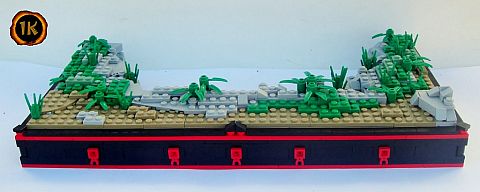
For many LEGO creations the base is the first thing that needs to be built. Of course sometimes one builds a LEGO vehicle or something that doesn’t need a base. And even if you do build a base, you may start out with some of the little details and then expand around that. But wherever you start the fact remains that for most LEGO creations a base is a key component. And the most important part of a base is that it is stable, and capable of supporting the entire MOC. The last thing you want is for your LEGO creation to fall apart the moment you move it! Fortunately there are several ways of making a sturdy foundation – each of them particularly suited for a certain style or genre of LEGO building. We’ll start with the most obvious one; using a LEGO baseplate, then move on to more advanced techniques.
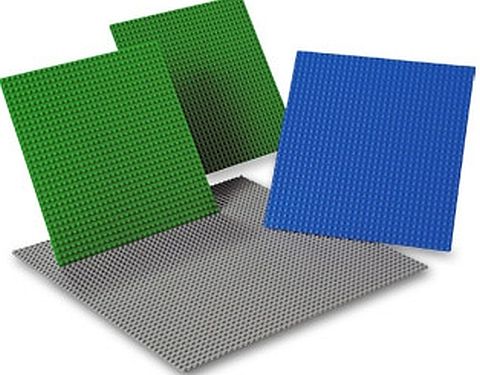
➡ USING LEGO BASEPLATES – LEGO baseplates can significantly cut down on the amount of time it takes to build a base for your LEGO model, as they are specifically meant to provide a foundation for your LEGO creations. Pay attention to the color of the baseplate you are using though. For example, if you are using tan elements to look like sand on a green baseplate, the edges will end up looking like the sand is growing out of the grass! Not good. Below is an example of the unsightly green line I’m referring to. The overall MOC would have been much improved without it.
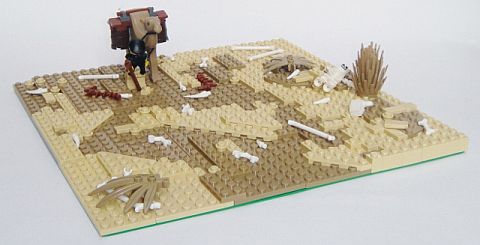
To avoid this syndrome, and if you can’t find the right color baseplate, you can attach regular LEGO plates at the edge of the baseplate – overhanging by 1 or 2 studs – and making the baseplate pretty much invisible. But this does mean that the entire base will have to go up at least a plate-height on every side, which could hamper your overall design. And of course this also means that there’s really not much reason to use a LEGO baseplate as opposed to some other method.
➡ USING A GRID-BASE – Another option for making a LEGO base is to use a grid formation, generally with something like 6-8 studs between lines. This works especially well if you want to cover an entire area with a color you don’t have baseplates for. A grid also ties in well with a border around your LEGO creation. The key is to use a color you won’t need in the rest of your model (unless you have a very large LEGO collection). I generally use red and yellow, because I have quite a few of each, and rarely use them for other purposes. Though a grid can be unstable at first, after adding plates and landscaping on top it is usually very sturdy! Below is an example of a LEGO creation on a grid-base:
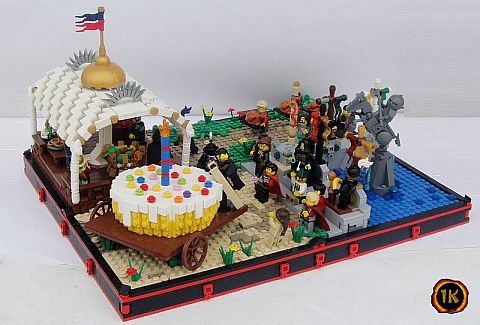
➡ IRREGULAR LEGO BASE – Yet another possibility for your LEGO model is an irregular base. This is a base made out of LEGO wedge-plates arranged in a non-symmetric formation. While not quite suitable for a building (in my opinion at least), it works very well in a landscape-focused model. Legonardo is quite the master at this, and the example below is one of his works, but there are several other excellent LEGO creations that utilize the same technique; among them Gideon’s fantastic The Dune Sea, Blake Baericks’ amazing Swiss Family Robinson, Yacapo’s neat little Stranded…, .Bricko’s funny The truth is…, and Masa of Kaliphlin’s cute The Pretzel Thief.
➡ LEGO SNOT BASE – Another great LEGO base technique is SNOT (Studs-Not-On-Top), or sideways building. One way to do this is in a rectangular shape, but it also has a very nice effect when done with slopes and inverted slopes. The slope-method gives a nice combination of smoothness and angles that works well especially for snowy MOCs. Like the irregular base, slopes work best in landscape settings (rock, water, grass, snow), rather than in the middle of a town. A few examples of both types of SNOT bases are Yacapo’s Winter Traveler (slope), Si-MOC’s 40-Love (rectangular), Sirens-of-Titan’s Erebus Gate (slope), and Mark of Falworth’s A Struggle in the Swamp (rectangular). The example below is one I built myself.
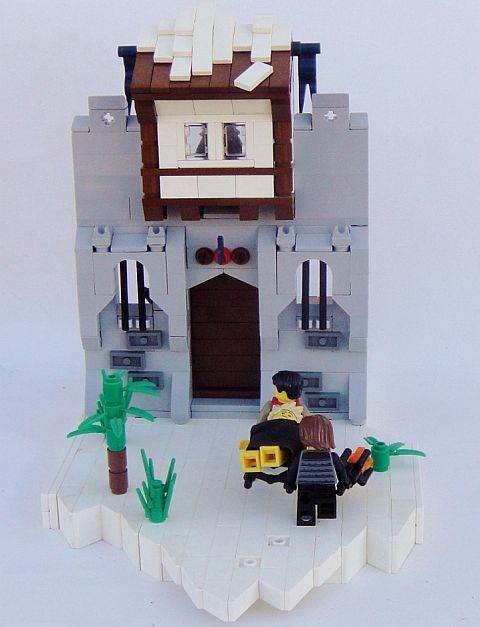
➡ ROUND LEGO BASE – Making a round LEGO base is a challenge in and of itself, and one that isn’t attempted too frequently. Both the above mentioned irregular and SNOT techniques are useful for this, but Brick-Bending (see an article on Brick-Bending here) also works well for large MOCs, as is the case with Blake Baericks’ Ice Age: The Meltdown. For smaller LEGO vignettes, using a tire is quite a creative idea, as in K.Kreations’ New Mushrooms. Below is ‘LL’s creation called Visit, also an excellent example of a round based MOC.
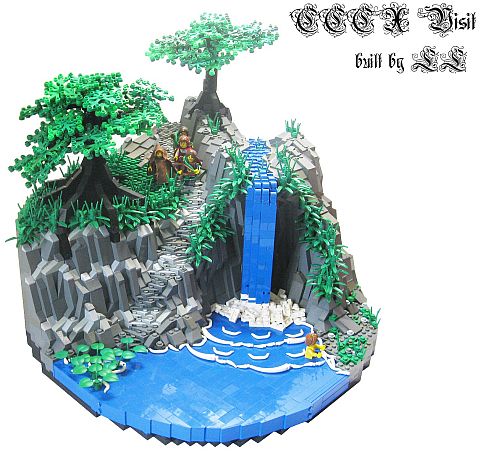
Of course there are plenty of other ways to make a base for your LEGO model, but I hope the above examples get your creative juices going! So now you’ve got lots of examples of a good LEGO base, but what about a border? Not all bases need borders – fortunately – but a border can give a LEGO creation a professional finish that a simple baseplate foundation can’t really provide. Borders can be elaborate SNOT work, or something as simple as a layer of black bricks and tiles. An example of a simple black border is Sir Edwin’s Revamping the Ruins, or cmaddison’s The Invasion of Denas Brenhinol. And a few SNOT examples are ZCerberus‘ Marecroft Manor, Masa of Kaliphlin’s Okatowan Gardens, and Ecclesiastes’ Encounter. Below is a very original LEGO border example by eilonwy77.
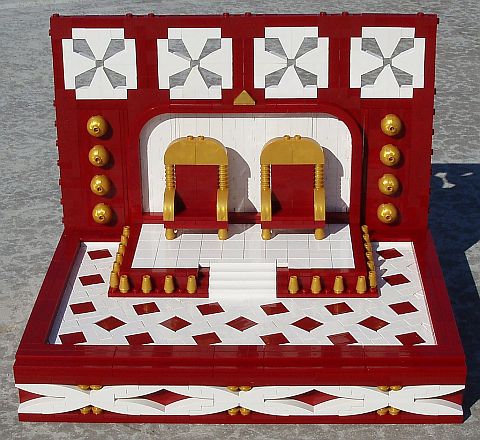
So what do you think? What techniques do you use for making bases and borders for your LEGO creations? Have you tried any of the techniques mentioned here? Are you planning to? Or have you come up with something unique and different? Feel free to share in the comment section below! 😉
And you might also want to check out the following related posts:


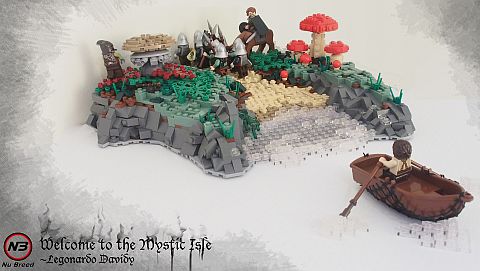










Awesome, Tips Gid! I have 4 32×32 Green 1 32×32 Blue 1 48×48. What I want LEGO to do is make baseplates in lots of colors. Cause I want to make a Star Wars Geonosis MOC, but to cover a 48×48 baseplate with 4×6 brown plates you need 96 of them! And that is a lot of money!
Yep! Me too! I would love to see baseplates in more colors! Sadly; LEGO has been in fact reducing the number of baseplates available, and in many sets switched over to not using a base at all, or using regular plates. They are still available in large sets though, and also on Bricklink.
For your Geonosis MOC you may consider getting a light-gray 48×48 baseplate. It would not look as strange as blue. They are available on Bricklink. Or if you don’t mind making the MOC smaller, the 32×32 one is available in tan for about $6. Not too bad. 😉
Whoops, My base plate list is wrong :blush:
4 32×32 Green 1 Blue 32×32 1 Grey 48×48
So maybe use the gray one for your Geonosian MOC? It is easier to cover up and a little gray won’t hurt the landscape. 😉
More baseplate colors would certainly help! I generally prefer plates to baseplates though like you say covering a lot of space with them uses a lot. A brown baseplate would really come in handy though!
If you remember the creation I made for the competition, you can see that I used a base: A regular green baseplate. It doesn’t really match the industrial feel I was going for, but it was mandatory to use the baseplate for your creations, so oh well. I tried to get the industrial feel with the border, but everybody can see it’s very crude, and composes out of very juniorised pieces…But I think I got the point through.
Yes, live competitions are difficult because you are limited in both time and resources. But as you said; the judges still saw the awesomeness of your entry! 😀
You could just claim it was a puddle of chemical waste…
LOL! Yeah! That too! Very creative! 😈
Ya! An article by Geneva! Haven’t seen you in a long time here!
I’m actually around quite a bit, though I don’t comment as much as I used to and it has been a while since I wrote an article!
Aren’t you visiting friends in the US?
No, not yet. I’d probably comment more actually, except that my browser for some reason doesn’t save my name, etc. any more.
Probably your cookies got cleared. Check your browser settings. 😉
Yeah, I bet it’s something like that. I’ve fiddled around with the settings several times but nothing seems to work… 😕
Just tried again though. Hope it works this time!
Good luck! Computers can be tricky and cranky at times. 👿
interesting, I have they gray base plate but I’m not so sure what to do with it. I have a smaller LEGO collection than ALOT of people 🙁
Yeah, it can be hard to use up a whole baseplate if you don’t have too many bricks to work with. I actually just have a few green road baseplates (32×32) and four 16×16 (one yellow, the rest green), but especially for some types of builds!
*but using the whole thing up can be hard especially for some types of builds!
That’s what I get for posting too quickly I guess!
I realize I own all those baseplates, and I bought some crater and old road plates on a flea market rather cheap this summer… Four of the crater plates, enough to build a whole round crater… Don’t know yet what to fill it with, though…
Grey base plate? Well, it’s good as a foundatioon either for a city or a barren landscape, I think…
It’s a shame Lego has cut down on the baseplates.
I have heard LEGO cut back on baseplates because younger kids tend to bend them/break them due to the thinner plastic. I don’t know… LEGO baseplates have been around for quite a while and generation of kids grew up with them. Why all of a sudden baseplates are a problem I’m not sure. Maybe today’s kids are rougher? 😐
I have a few broken baseplates in my collection. I think most of them could be due to my brother deliberately breaking or cutting them since they had the wrong shape or something.
The official reasoning sounds a bit strange, though, since even broken baseplates generally work fine for building and playing.
On Bricklink I see a few vendors selling baseplates in colors that officially shouldn’t exist (?) Not sure if it’s due to bad parts indexing, errors or clone brands/ piracy.
Hakan, it is actually quite common to see parts that are not in sets on Bricklink in colors that souldn’t exist (as you said it) because they don’t appear in any sets. These are usually from LEGOLAND parks and LEGO model shops. Some are readily available, and some are very rare. It is also true that some items are just listed wrong though, but if they are from a reputable seller and you see several sellers listing the item, and there are also finished sales, you can be pretty sure that the color is correctly listed. And of course you can always ask. The point is that just because a color doesn’t appear in a set it doesn’t mean it can’t exist. I own a number of LEGO elements like that myself. 😉
Aha. That’s interesting. Thanks for the info.
I think I could still see some traces of my brother’s cutting approach in my collection, such as Technic axles being of the wrong length and the front glob of these old Space metal detectors. I couldn’t recommend kids to try it at home, but you could make a decent ray gun by adding a trans red cone brick to the shaft, and the cut off glob had studs at both sides and could be used for interesting SNOT building.
I never did anything like that, I recall. I just broke a few pieces by stepping on them… =/
I guess you could consider it as a Custom and Purist approach, respectively…
Either ways, it still makes me feel rather queasy…
I’ve never had any problem with baseplates breaking but that could be a problem for young children. That reason does seem strange though.
In my mind though a baseplate that doesn’t have some thing on it about, oh, every 10 studs (at most), looks a bit bare and doesn’t make the set (or MOC, though there are exceptions) look as professional. I really couldn’t imagine most of today’s sets stuck on a baseplate…
I don’t know. Checking out Brickset, I see that most of the sets that would have warranted baseplates in the 90’s today just use regular plates as bases.
It’s still difficult to see the reasoning behind it. A serious risk of breakage seems unlikely. Would the molds be harder to manufacture and the baseplates more expensive to produce? Could it be that they are harder to transport or place in sets due to their size? Cutting down on baseplates as another cost-cutting measure? If you could put in three times as many sets in a transport truck, you could probably earn a lot on global transportation… =/
Yeah, those are all good questions. The thing though is that LEGO is still manufacturing baseplates and sell them individually and they are also in the large Creator sets. So it is not like they completely stopped. They are just using them less frequently in smaller sets. So I don’t know… maybe we should ask Kevin…
But individual baseplates are easy to transport.
That “breakage” reason sounds a bit strange, since Lego still produces a lot of pieces that – in my experience – break easier than baseplates, as well as turn useless when broken, such as 1×1 clip plates, flags, shields etc…
Just speculating… I don’t know how high the commercial demand for baseplates are… (Particularly in sets, and of smaller sizes.) If the kids don’t care about them, they’re unlikely to make a return…
I really like 16×16 baseplates. They are great for micro-building, but you can also build a decent size minifig-scale MOC on it as well without the bareness issue you mentioned. And if you need a bigger surface you can connect several of them. And it comes in many colors! 🙂
Ah… I really haven’t been paying enough attention to my typing today… I meant 16×32…
Yes, I agree that 16x16s are very nice! I could certainly go for LEGO using more of them!
I think I have a bunch of old 16×32’s lying around in my collection. Pretty handy.
Nice article! I’ve never put a border around an MOC before but I like the grid technique. It seems like it would go best with a border.
Thanks! Yeah, grids pretty much need borders. They are fun though! 😉
Beautiful article!
I love all of your posts!
~Brick
It’s pretty easy to make custom sized base plates from a large one. Use a metal straight edge and score the plate with a box cutter. Go over the score three or four times. You don’t have to go very deep at all. Then simply bend the plate and it will snap where you scored it. Nice clean edge.